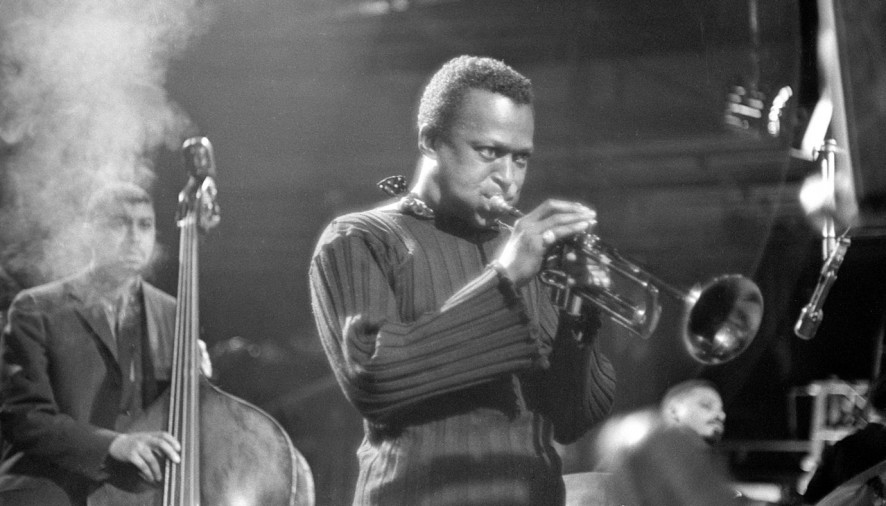Released in 1959, Kind of Blue remains today as one of the freshest and most innovative compositions ever produced. Moving away from the hard bop style of jazz that Davis had grown tired of, Kind of Blue is based entirely on modality, giving it a freedom and fluidity unparalleled by many jazz albums before or since. Consistently ranked as one of the greatest albums of all genres, let alone just jazz, the album‘s ability to inspire listeners of all backgrounds stands testament to this.
And this is the case with the jazz art form as a whole. Born in Black American communities across America, the structure, rhythm and style of jazz has arguably inspired, to some extent, almost every modern musical genre. Most notably in the syncopated beats of modern R&B and hip hop, but also in the chord progression foundations of folk, pop and rock & roll. Wherever you look you can see the tributaries of jazz flowing into the worldwide discourse of the music industry‘s rich reservoir, its ripples reaching far and wide across its dynamic surface.
What I find so compelling about Kind of Blue is how it embodies the bleak but courageous record of Black History. Within the chambers of Davis‘ trumpet echoes the soulful songs of slaves bursting to escape, and the influence of their torturous trial can be heard throughout the album. Every reverberating moan from his solos sounds like an appeal against prejudice, a demand for equality, a cry for freedom. The laid back, almost lazy roll of the swing time drums, the smooth piano slides of Bill Evans‘ magisterial grace notes, John Coltrane‘s ground breaking and mind blowing sheets of sound; all culminate in a sincere and honest reflection on life‘s burdens. Kind of Blue therefore, like all jazz, represents the throwing off of this oppressive mass in a bid for artistic independence. Even if the album was not formed with political motives, the inescapable weight of Davis‘ revenant ancestry is inextricable from his music.
Amazingly, Davis only provided his band members with brief instructions and song outlines on the day of recording, and Kind of Blue, whilst only five tracks long, shines as a stalwart of jazz through its improvisational vivacity and unsullied production. The liquid ‘So What‘ is an upbeat opener that throws off the shackles of segregation with lackadaisical ease. ‘Freddie Freeloader‘ continues this trend with more aggressive yet still gorgeously fluid melodies. Arriving at ‘Blue in Green‘, this spirited soliloquy tells a sombre tale of sorrow that morphs into ‘All Blues‘: a twelve minute master class that, recorded in just two takes, reflects the purity and deceptive effortlessness of jazz. Concluding the album, ‘Flamenco Sketches‘ is a dreamy lament on existence, and whilst it doesn‘t leave a bitter taste in our mouths, it reminds us that success and freedom in music don‘t necessarily correlate to success and freedom in life; the struggle for racial equality still rages as fiercely as it did during Miles‘ generation.
Despite its success, Davis was never content to rest on the blissful laurels that Kind of Blue created, instead he was constantly searching for new sounds and methods of composition. Much like the civil rights movement he supported, Davis refused to let others classify him by his genre, and strove for a freedom of expression that translates across all borders of art and politics.
Nevertheless, Kind of Blue represents such an important cornerstone of jazz and music as a whole, that its impact on society cannot be understated. In 2002, Miles‘ masterpiece was added to the United States‘ National Recordings Registry – a list of recordings that are culturally, historically or aesthetically important, informing and reflecting life in the United States – due to its boundless influence and affirmation of jazz as a key foundation within American culture. Its embrace of its roots and subsequent shaping of humanity‘s tree of life provide a strong justification for how it was certified quadruple platinum in 2008, and why it is still beloved by modern audiences across the globe.
So even if you don‘t like jazz yet Black History Month has sparked a taste for adventure in your imagination, or if mounting assignments and that housemate who keeps stealing your food have got you feeling down and out, then do yourself a favour and listen to Kind of Blue. As an album that defines its genre, it also has the ability to define its listeners, and it will genuinely change your life… or at least your day.
Robert Cairns

